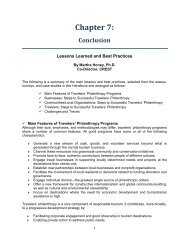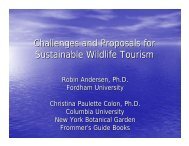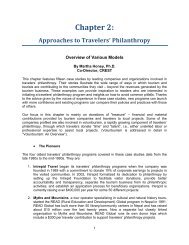Travelers' Philanthropy Handbook - Center for Responsible Travel
Travelers' Philanthropy Handbook - Center for Responsible Travel
Travelers' Philanthropy Handbook - Center for Responsible Travel
Create successful ePaper yourself
Turn your PDF publications into a flip-book with our unique Google optimized e-Paper software.
and institutions is crucial <strong>for</strong> addressing basic needs and supplying services not fulfilled by thegovernment. The U.S. also has a “generous tax regime” <strong>for</strong> private philanthropists. 5 In addition,in the U.S. the top 10% of the population controls 70% of total national wealth. Those wealthierindividuals give about half of total individual donations. In comparison, the wealthiest 10% in theUK control 56% of the national wealth and account <strong>for</strong> just 20% of all individual giving. 6• Origin of <strong>Travel</strong>ers’ <strong>Philanthropy</strong>While there is a long and rich tradition of travelers and tourism companies supporting projects inhost communities, it is only over the last decade that the concept has acquired a name, startedto coalesce into a more organized global movement, and begun to establish procedures andbest practices.I first became aware of this phenomenon in themid-1990s, as I was researching a book onecotourism. 7 I was surprised and inspired tocome across ecotourism businesses in far flungcorners of the globe that were supporting health,education, basic infrastructure, microenterprises,and conservation projects in localcommunities. These early initiatives, typicallybegun by companies whose owners andmanagers had strong social and ethical values,sprang up independently in response to localneeds, and without coordination or fanfare.There was not even a common name <strong>for</strong> whatwas happening.Donor bike ride across Tanzania.Credit: The Foundation <strong>for</strong> TomorrowIn an ef<strong>for</strong>t to facilitate communication andlearning among these early innovators, I proposed to Michael Seltzer, director of the New Yorkbasedorganization, Business Executives <strong>for</strong> Sustainable <strong>Travel</strong> (BEST), that he convene ameeting of some of these pioneering tour operators and lodge owners. Seltzer picked up theball, coined the name “travelers’ philanthropy”, and convened two gatherings.In November 2001, BEST held the first-ever summit on travelers’ philanthropy at PuntacanaResort in the Dominican Republic. The summit brought together about a dozen businesses andcommunity foundations that were pioneering this emergent <strong>for</strong>m of “on the road” giving. InSeptember 2002, BEST invited 25 people to a second summit, including executives fromLindblad Expeditions, Turtle Island in Fiji, and CC Africa (now &Beyond), and other corporateleaders. This meeting was held at White Oak Plantation in Jacksonville, Florida, under theaegis of the Howard Gilman Foundation. In a White Paper prepared <strong>for</strong> these meetings, Seltzerdescribed <strong><strong>Travel</strong>ers'</strong> <strong>Philanthropy</strong> as providing "3 T's" of support - time, talent and treasure - tohost communities.5 P.A.P.-Blog, “Statistics on International Development Aid,” http://filipspagnoli.wordpress.com/stats-on-human-rights/statistics-onpoverty/statistics-on-international-development-aid/#17.6 http://philanthropy.org/resources/usphilanthropy, quoted in Goodwin and Eckardt, “<strong>Travel</strong> <strong>Philanthropy</strong> Report,” p. 2.7 Martha Honey, Ecotourism and Sustainable Development: Who Owns Paradise? Washington, DC: Island Press, 1 st edition 1999and 2 nd edition 2008.5















